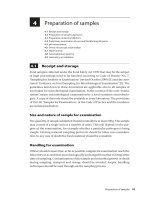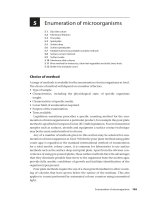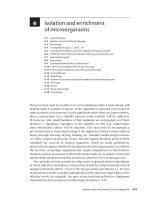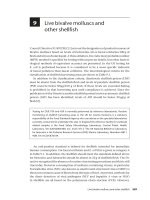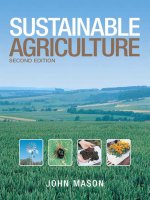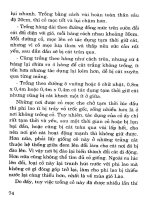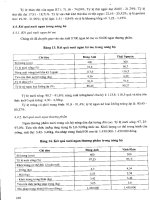SUSTAINABLE AGRICULTURE 2nd Edition - Part 6 pptx
Bạn đang xem bản rút gọn của tài liệu. Xem và tải ngay bản đầy đủ của tài liệu tại đây (171.03 KB, 12 trang )
What is a weed?
The generally accepted definition of a weed is any plant that, for some reason or other,
is unwanted in a particular position. Any type of plant has the potential to be a weed.
Common reasons why people do not want species to grow include:
•Competition – weeds can compete with your desired plants for space, light,
nutrients and moisture
•Safety – some plants may be poisonous or cause allergies (eg St John’s wort, bathurst
burr, parthenium weed), others may have spines or spikes (eg giant devil’s fig,
currant bush and Chinese apple) or sharp grass seeds that can injure animals and
humans (eg spear grass)
•Harbouring or hosting pests and diseases – some plants may act as hosts or as
attractants to pests or diseases, while others may provide a safe haven for pests such
as rabbits and foxes
•Tainting – some weeds (eg capeweed, wild garlic) can taint the taste of meat and
milk from animals such as cattle, sheep, goats and pigs
•Contamination – plant parts, particularly seeds, can get caught up in clothing, or
can contaminate produce, such as grains, or get entangled in animal fur or fleece, or
fibre crops (eg cotton), or in hay
•Interfere with cultivation – some plants can become entangled in machinery,
making tasks, such as cultivation, mowing, or machine harvesting difficult, and
possibly damaging machinery
•Soil erosion – some weeds are very competitive and will easily shade out other more
desirable plants; if the weed is only seasonal (eg an annual, or dies back during
winter), it may leave exposed soil that may be easily eroded
•Aesthetics – some plants may be weeds simply because they look bad, or they have
offensive odours
Sustainable natural weed control
and cultivation
6
•Environmental – these are plants that invade native vegetation, displacing the
indigenous species; they can severely affect local flora and fauna populations (eg
lantana, camphor laurel, Singapore daisy and water hyacinth).
Controlling weeds
Once it is determined that a particular plant or group of plants is a weed, we need to select
a suitable method to control it. Chemical methods are the mainstay of weed control on
most farms. Weedicides certainly give a quick result, but also have the following problems:
•They can be quite expensive
•There may be legal requirements with regard to their use and storage, and training
of operators
•Chemicals can damage other plants, especially if they are applied in windy or hot
conditions
•They can wash off in rain and either don’t work, or they may run into other areas,
causing damage to other plants
•Ifyou get the concentration wrong, chemicals can actually promote rather than
deter growth; some blackberry killers, for example, used at low concentrations cause
more rapid growth
•High concentrations can poison the ground and, in extreme cases, prevent further
plant growth
•Chemicals can be harmful to animal life including humans, domestic pets, birds,
fish, and soil life
•The manufacturing processes involved in making the weedicides can cause pollution
problems
•Old weedicide containers pose a safety risk unless carefully disposed of
Even in ‘sustainable farming’ methods such as conservation tillage, chemical use is
common. It would be extremely difficult for most farmers at present to completely stop
using such chemicals; however there are some non-chemical control methods that can be
readily applied and which can significantly reduce the farmer’s dependence on weedicides.
You should first:
•Know the weed or weeds you are dealing with
•Know how those varieties grow, and what conditions they do and don’t tolerate
•Then create conditions which they don’t like
You need to consider whether you want to kill or just control the weeds. When you
know these things you can consider which method is best for your situation.
Ways to control weeds without chemicals
Check soil condition
Weeds are much more of a problem if your soil is infertile, poorly structured, or is regularly
disturbed in some manner, such as by excessive cultivation. Keep your soil in good condition
(eg fertile, properly drained and friable) and your plants will compete strongly with weeds.
Sustainable Agriculture
102
The first step to control weeds is to improve your soil:
•Use soil ameliorants, such as lime or gypsum where necessary
•Add organic matter regularly (as a mulch or dug in before planting)
•Fertilise your plants regularly
•Improve drainage if necessary
A good cover of plants will also reduce the likelihood of weed invasion. Bare, disturbed
soil creates the ideal opportunity for weeds to become established.
Minimise sources of weed seeds
The next step is to control the source of weed seeds. If you stop weed seeds getting onto
your property, you will stop most weeds from becoming established.
•Give first priority to removing any weeds in flower before seed is produced. It may
be necessary to look outside of your property to see where the weed seeds are
coming from. They may be blown or carried in from elsewhere. You may possibly be
able to control this by such means as slashing down weed plants immediately
adjacent to your property, perhaps on road verges or adjacent bushland verges.
•Be careful not to bring any contaminated plants, soil or mulch (or anything else
containing weed plants or seeds) onto your property. Materials, such as fresh
manures or grass hay to be used as mulch, should be composted before being spread,
to kill off as many as possible of the large numbers of seeds that they usually contain.
•When bringing in animal stock from elsewhere, place them in a confined area for a
week or two, so that any weed seeds they may have in their digestive systems are
passed out, and can be easily controlled as they germinate, rather than being spread
over a much larger area, making control more difficult. This has the added
advantage of keeping the new animals initially isolated from your existing stock, in
case they have pest or disease problems which haven’t been noticed. If you are
buying fleeced animals such as goats and sheep from areas where problem weeds are
present, these can be obtained shorn, so that the possibility of transferring weed
seeds in the animal’s fleece is greatly reduced.
•Any machinery that has been used in areas with weed problems should be hosed
down before being moved to a weed-free area.
Cultivation
Cultivation (ie digging or turning the soil with a spade, hoe or engine-driven cultivator)
will disturb weed growth and, in the case of annual weeds, often kill the weed.
•Young weeds are damaged more by cultivation than established weeds
•Do not water the soil after cultivation (the hot sun kills exposed roots)
•Some weeds will die quickly when you cut the top from the roots (others will regrow
from the smallest piece of stem or root lying in the soil)
•There will always be some hard to kill weeds which need removing by other
methods, some weeds are almost impossible to control, even by hand, unless you
have a lot of patience
•Some weed seeds germinate very quickly after soil disturbance
103
Sustainable natural weed control and cultivation
Mulching
A popular weed control method is to suffocate the weed (block out light) and/or put a phys-
ical barrier over it which it can’t grow through. This is most commonly known as mulching.
What mulching does is to kill weeds simply by smothering them. The weeds are deprived of
light and in order for them to grow they have to break through the barrier formed by the
mulch. A mulch can take the form of almost anything, but the more popular ones are:
•Wood shavings and chips
• Pine bark
•Hay or straw
•Grass clippings
•Leaves
The depth of the mulch will be determined by the weeds that you are trying to control.
Vigorous weeds will need a greater depth of mulch than perhaps small annual weeds. Most
weed seedlings will require a depth of mulch of 8–10 cm over the top of them. This thick-
ness can be reduced by mowing the weeds then covering with a thick layer of newspaper
(perhaps 15 to 30 sheets thick) before laying down the mulch. Grass clippings or hay that
may contain large numbers of seeds should be avoided.
Mulch mats – these are also known as weed mats. They are usually made of a closely
woven fabric perforated with holes large enough to allow water to penetrate, but small
enough to prevent most weeds from growing through.
Biological weed control
This involves introducing natural predators into an area to attack weeds. It is a method
which has been used occasionally with dramatic results, but which can backfire if the full
implications of introducing something new into an environment are not understood.
Sustainable Agriculture
104
Figure 6.1 Prickly pear (Opuntia sp.) – this weed was a massive problem in Australian pastures
until the moth Cactoblastis cactorum was introduced as a biological control agent. Prickly pear
is now rarely seen.
•Newspaper
•Carpet underfelt
•Cardboard
•Seaweed
•Sawdust
Examples of biological control of weeds:
•Prickly pear (Opuntia sp.) – This cactus was a severe problem in the past in New
South Wales and Queensland, but was brought under rapid control in Australia by
introducing a parasitic moth (Cactoblastis cactorum) which has a grub that attacks
the plant.
•Blackberries – A rust (fungal) disease was introduced into Australia in the 1980s in
an attempt to control blackberry weeds. Though this has had some effect, to this
stage it has only been a mild deterrent.
•Water hyacinth – Insects have been used to control the spread of water hyacinth in
the United States and Australia.
Grazing
Regular grazing of larger areas will effectively control many weeds and keep grass down to
an acceptable level. Grazing animals should be well fenced in to ensure that they only eat
what they are supposed to. Simple electric fences can create a temporary enclosure in areas
that are not regularly grazed. Smaller grazing animals (even poultry will graze out many
weeds) should be protected from predators (eg dogs, cats, foxes). An adequate supply of
clean water is also vital. The manures of such animals can supply valuable plant nutrients
to your property.
Goats
Goats are excellent for controlling weeds. They eat virtually anything. The trick is to keep
them in the area where the weeds are and keep them away from any valuable plants. Here
are a few hints if you’re considering a goat:
•For small properties it is better to borrow a goat than buy one. Otherwise, when you
run out of weeds, feeding it can become a problem.
•Goats are best used to keep a wild area under control on a large property or to clean
up an area prior to growing a crop.
•Goats are very strong, they can break small gauge chains, eat through ropes and pull
stakes out of the ground. You will need to have them strongly fenced or use a heavy
chain and tie them up to something very solid such as a fence post or large tree.
•Goats will stand on their back legs to reach plants; they will eat all types of plants
and even strip the bark off trees.
Other grazing animals
Sheep can also be used for grazing, but can be a little more choosy in what they are
prepared to eat. Poultry will also eat a variety of weeds, and cultivate the soil by scratching.
Penned pigs will also cultivate the soil with their digging. Wire netting is sometimes placed
on the ground in a poultry run to stop hens digging up the soil too much.
Chemical control of weeds
Prior to the development of purified toxic chemicals at the beginning of the 20th century,
sea salt was the only widely available herbicide (weed killer). During the 1940s selective
105
Sustainable natural weed control and cultivation
herbicides were developed and today herbicides come in a range of products of varying
toxicity. Since the 1970s, the level of herbicide tolerance and resistance has steadily
increased, due to continual use of chemically similar herbicides. In recent times, it has also
become obvious that herbicide reliance requires ongoing use without ever reducing the
problem. Herbicides should be used in conjunction with other weed control methods.
Herbicides
Herbicides can present a significant danger to non-target organisms. In particular, residual
and foliar applications have the potential to kill desired plants, poison animals, reduce soil
micro-organisms, evaporate into the atmosphere and enter the watertable.
Herbicide use is controlled by governments through laws and regulations. Before using
any herbicide, check with your local authorities that it is authorised for use in your area.
Always read the label before use and always follow the application rates and safety instruc-
tions as directed.
Herbicides can be liquid or granular preparations applied to foliage, stems or the soil.
Their action can be systemic or contact and they can be residual or non-residual in the
environment. Most herbicides are non-selective and kill most plants they contact.
Sea salt
Easily the cheapest of all herbicides, it is sold as non-iodised or cooking salt and is effective
against many leafy weeds. Dissolved in water, it is taken up by the plant systemically.
Problems with residual salt in the soil prevent its widespread use.
Glyphosate
Sold under trade names such as ‘Zero’ and ‘Roundup’, glyphosate is a systemic, non-residual
and non-selective herbicide spray that is widely used around the world. Its systemic action
means that it will not eradicate many plants with bulbs or other food storage mechanisms.
It acts by interfering with enzyme activity in plants. Because there is no equivalent enzyme
activity in animals, it is considered ‘safe’ for use. In recent times, some weeds have begun to
develop resistance to glyphosate.
Contact herbicides
Contact herbicides include the non-selective, non-residual compounds paraquat and
diquat. These herbicides must be applied evenly to the target plant to be fully effective.
They are poisonous if inhaled or swallowed.
Wo odyweed herbicides
For persistent weeds such as blackberries and trees, it may be necessary to use stronger
chemicals. These chemicals are non-selective and systemic. Examples include amitrole
(Weedazole®) and triclopyr (Garlon®). In some areas, the use of these chemicals is now
restricted to licensed operators.
Residual herbicides
These systemic herbicides are applied to the soil to prevent weed seeds germinating, usually
during cultivation or irrigation. They include amitrole and simazine. They have long-term
persistence in the soil and are likely to enter the watertable after periods of heavy rain.
Sustainable Agriculture
106
107
Selective herbicides
These chemicals are systemic and only poison one type of plant, either broad-leafed weeds
or grassy weeds. This means they can be sprayed on crops with unsuitable foliage. Some of
these chemicals, including MCPA and 2,4 D, act by interfering with hormone activity in
plants (and animals). They are highly toxic and residual in the environment. In a number
of countries, many of these chemicals are now either banned or strictly controlled.
Herbicide additives
Dyes
Non-toxic coloured dyes such as food dyes are sometimes added to herbicide sprays. This
reduces wastage by allowing the operator to see where they have already sprayed. It also acts
as a warning to visitors that herbicide has been used in the area.
Surfactants
These are additives that help keep the herbicide mixture on the surface of the plant leaf.
They include soaps (beware – soap suds can block spraying equipment) and various
commercial preparations.
Other weed control methods
There are other non-chemical methods of controlling weeds, however most tend to be
‘drastic’ techniques which not only kill weeds, but can kill everything else at the same time.
Such techniques might be useful in some situations such as clearing a new area prior to
planting, or weed control on fence lines. They are often unsuitable for treating existing
crops.
Mowing / slashing
This involves regularly cutting the tops from the weeds. The cut foliage should be left to
rot and return nutrients back into the ground. If the weeds are tall when cut, the foliage
will act as a mulch, slowing regrowth of weeds. Cutting close to the ground does more
damage to the weeds than cutting high. Whipper snippers (ie brush cutting machines) are
ideal for this.
Flooding
Flooding an area will kill a wide range of weeds (but not all). This is sometimes used on flat
sites prior to planting.
Solarisation
Large sheets of clear plastic are spread over the surface of the ground in warm weather.
Heat generated under the plastic can be great enough to kill many types of weeds. The plas-
tic can then be removed (perhaps after a couple of weeks) and the area planted. This tech-
nique will also often kill other pest and disease organisms, but it is only suitable for
relatively small areas.
Sustainable natural weed control and cultivation
Burning
Flame throwers are used by some government bodies and farmers for killing weeds on
boundary fences, or large clumps of weeds such as blackberries. Be sure not to burn the
fence. Care should be taken with this technique as the heat generated can be quite consider-
able and can damage other plants, as well as causing nasty burns to the operator.
Controlled burning of areas is sometimes used to suppress weed growth. Fire should
only be used by skilled operators, and never in an area where there is danger of a bushfire
occurring. It is very important that you check with your local fire brigade for advice and to
ensure that burning-off restrictions are not in force.
Avoid creating fire piles or bonfires in areas that are to be used later for growing crops.
The intense heat of a fire maintained for any length of time in one position can sometimes
scald the earth surface or kill beneficial soil organisms, making it difficult to grow any
plants in that area for some time. As well, the concentration of particular plant nutrients
such as potash (potassium) can also have a major effect on plant growth.
Changing soil pH
Every plant has its preferred pH range. Changing soil pH can sometimes be used to control
some types of weeds. For example, by raising soil pH you can discourage growth of sorrel
(Rumex sp.). Adding organic matter to the soil will also gradually cause sorrel growth to
slow down.
Harvesting your weeds
Instead of simply getting rid of them,
there are a few weeds that can be
harvested for your own use. One of the
most common is the dandelion
(Ta raxacum officinale). The leaves can be
used as a salad green, the flowers in pot
pourri, and the roots roasted and
ground as a coffee substitute.
Weed control with hot water
This environmentally friendly method
involves spraying extremely hot water
onto weeds. Impressive results have been
obtained through research at Florida
Citrus Research Institute and California
State University (Fresno). In most tested
cases, both broad-leafed weeds and
grasses have been effectively controlled.
The equipment for this technique is
available from ‘Spray Tech’ at Nerang,
Queensland, Australia.
Sustainable Agriculture
108
Figure 6.2 This weed control steamer is used to kill weeds
without the need for conventional weedicides.
Plants that take over
Many garden plants can become weeds. It is wise to think carefully about the vigour of
plants you use in your farm garden and, if you want to avoid creating weed problems else-
where on your property, avoid planting the following types of plants:
• Plants that go to seed freely; during the growing season, some plants set prolific
amounts of seed, which mature and fall to the ground. These seeds may well
germinate during the growing season, or will germinate later on. Whatever the time
the seeds take to germinate, there will be a great deal of them and you can be faced
with a mass of new and unwanted seedlings. This can be a real problem if you have
crops growing nearby.
•Vigorous creepers that take root (eg periwinkle, ivy); this type of plant readily
spreads across shrub borders with long, branching shoots. These will tend to wind
themselves around the other plants and will also readily root into the ground if they
come into contact with it. This means that the plant is able to spread very rapidly.
Once these roots have become established, it can become difficult to control the
plant’s growth, and the only sure way is to dig the plants out.
• Plants that spread by suckers or underground roots (eg raspberry, willow, bamboo,
couch grass, kikuyu, many perennials). One of the main features with this type of
plant is that you do not know about the problem until it appears. As the plant is
spreading underground, the roots can travel some distance before they surface. Just
cutting the growth off where it appears will not solve the problem as the roots may
well reshoot from the buried root. You need to dig the root or sucker up along its
total length.
• Plants that have very rapid seedling growth; even a few seeds may grow very rapidly
and soon begin to bear seeds themselves.
Environmental weeds
Many garden and some crop plants can readily escape into bushland areas, where they can
compete or even completely take over from the native vegetation. The stability or balance
of natural systems can be upset, causing radical changes and, as a result, habitats for native
fauna can be severely damaged. Environmental weeds can greatly reduce the variety of
species present, and also may reduce access and recreational use by creating impenetrable
barriers of twining plants or dense thickets.
If suitable pollinators and seed-dispersing animals are present, exotic plants will flour-
ish without the pests and diseases that kept them in check in their original country, all at
the expense of the native plants. A European broom, for example, could replace a native
wattle. Plants may spread by being dumped (a common problem along railway lines and in
bushland adjacent to residential areas) or by seed, often carried by birds. Another problem
is that introduced plants can sometimes cross-pollinate with the local native (indigenous)
plants, for example Grevillea species and cultivars. This interbreeding results in hybrids
which interfere with the natural evolution of the indigenous plants.
In the middle of suburbia, growing these types of plants is not generally a great prob-
lem, but on farms, particularly if there are areas of native bush nearby, there is a strong
109
Sustainable natural weed control and cultivation
Sustainable Agriculture
110
chance of plants escaping. Many plants commonly used in windbreaks (eg tree lucerne) can
also pose similar problems. Many road and rail reserves, foreshores, bushland areas, and
national parks are now infested with environmental weeds. The situation can be so bad that
all weed control methods may be needed – including hand, chemical and biological
control. The loss of natural bushland is a great cost to the community, in lost educational
and recreational opportunities and the loss of indigenous plants and animals, as well as the
public funds used (or not used) to control the problem.
Some plants to avoid
Few plants become problems in areas that have climatic extremes such as snow, desert, etc.
Plants tend to become troublesome when they are introduced into areas that have a similar
climate to their native habitat. The following list, while not comprehensive, includes some
common plants that have become environmental weeds in some areas of Australia. The
table serves to highlight the importance of caution when selecting any plants for culture. It
is important to remember that a particular plant may be a weed in one area but not in
another. If you are not sure about which plants are problems in your area then contact your
local council, or state department of conservation, or perhaps a local conservation society
or tree planting group.
Table 18 Plants to avoid
Plant name Comments
Acacia baileyana (Cootamundra wattle) Native of south-east NSW that has become extensively
naturalised in other parts of Australia; widely grown in
gardens, and as a street tree
Acacia longifolia (sallow wattle) Heavy seeder; germinates readily and doesn’t need
fire; native that has naturalised extensively outside it’s
natural range
Albizzia lophantha (Cape Leeuwin wattle) A rampant seeder, a problem, particularly in sandy and
(syn Paraserianthes lopantha) coastal areas, fire enhances germination of the seeds
Chamaecytisus proliferus A popular fodder tree that can also become invasive
(tree lucerne, tagastaste) in some native vegetation types
Chrysanthemoides monilifera (boneseed) Rampant seeder, with seed remaining viable for some
time; a problem, particularly in coastal areas; easily
pulled out by hand, but follow-up checks are necessary
for several years to destroy new seedlings
Cinnamomum camphora (camphor laurel) This is often a prized feature tree in temperate gardens,
the fragrant timber is valuable for wood work; in
Queensland however, it has developed into a vigorous
and serious weed
Cotoneaster sp. Produces berries that are spread rapidly by animals
and birds
Cytisus scoparius (English broom) Heavy seeder that rapidly spreads in disturbed areas,
common on some road verges
111
Table 18 Plants to avoid (continued)
Plant name Comments
Hakea suaveolens (Sweet hakea) A West Australian native that has become extensively
naturalised in the eastern states and some overseas
countries; it rapidly spreads, particularly in coastal
areas, with prolific germination after fires; often planted
in windbreaks
Hedera helix (English ivy) Invasive creeper/climber with aerial roots; a major
problem in moist shaded spots, particularly in moist
native forests, where it smothers other vegetation,
including trees
Ipomoea indica Blue Morning Glory can be a problem in many parts of
Australia. Other morning glory species (Ipomoea spp.)
can also naturalise and become weeds in some areas,
despite their popularity as cultivated garden plants
Lantana camara An attractive, easily managed shrub in temperate
areas, a rampant weed in tropical regions
Lavendula stoechus (Italian lavender) Grown widely as a hardy herb plant but declared a
noxious weed in South Australia and Victoria
Lonicera japonica (honeysuckle) A rampant scrambler/climber that smothers other
vegetation
Pinus radiata (Monterey pine) Large tree that displaces native vegetation, particularly
in open or disturbed woodland areas
Pittosporum undulatum A native small tree that has spread extensively out of its
natural area of occurrence, displacing many indigenous
natives; the seed is spread easily by birds
Polygala myrtifolia Spread widely in sandy places, such as beach areas,
particularly in Victoria, SA and WA
Prunus cerasifera (cherry plum) Readily spread by animals, particularly birds and
humans; common on some roadside verges, and
along streams
Salix spp. (willows) A major problem in moist areas; they can completely
replace indigenous vegetation along streams, choking
the streams in the process; S. cinerea will spread by
seed, the others spread easily by vegetative means
Salvinia molesta A water weed that can choke lakes and streams, a
problem in warmer areas (eg NSW, Qld)
Tradescantia fluminensis A rampant groundcover/creeper in moist, shaded
positions; it self layers readily; similar plants which can
also create problems include Commelina cyanea and
Tradescantia albiflora
Thunbergia alata (black-eyed susan) Popular climber in temperate Australia, but a serious
weed in Brisbane and further north; other species of
the genus ‘Thunbergia’ are also potential weeds, and
should be used with caution
Verbena spp. Grown as a garden plant in temperate climate,
verbenas can become a serious weed in subtropical
areas; a rampant creeper, that suckers freely
Vinca major (periwinkle) A problem in moist, semi-shaded areas
Sustainable natural weed control and cultivation
Noxious weeds
In all states of Australia and in many other parts of the world, there are laws covering the
control of declared noxious weeds. Noxious weeds are those that present a serious threat to
agriculture, the natural environment and/or waterways. All landholders should be aware of
the noxious weeds in their area. After weeds are declared noxious by the local department
of agriculture, it is the responsibility of landholders to eradicate any noxious weeds on their
property. Failure to do so can result in serious penalties.
Sustainable Agriculture
112
